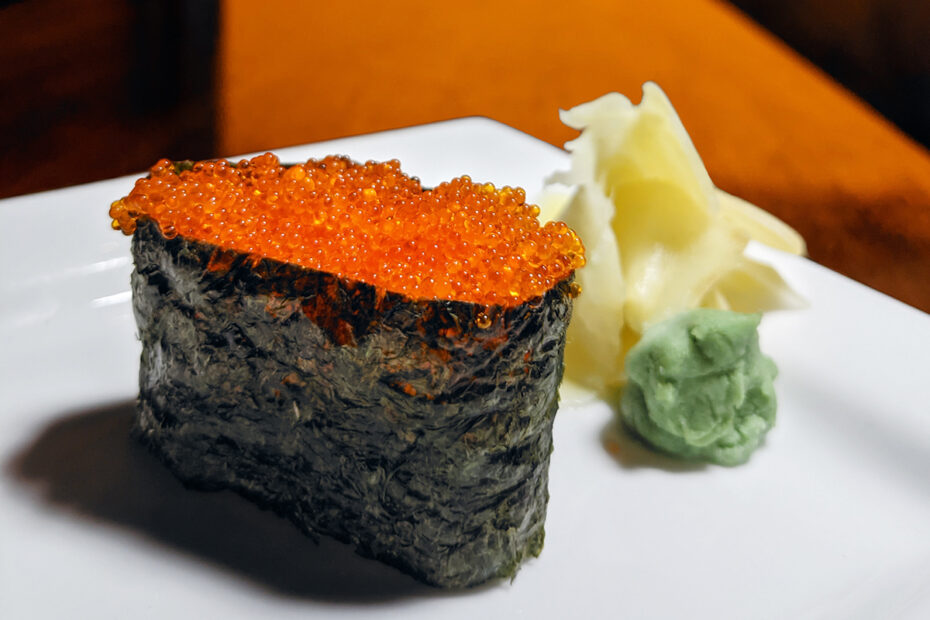Flying fish eggs, called tobiko (とびこ) in Japanese, is easily one of the most popular sushi ingredients. But it rarely takes the spotlight.
This post is dedicated to all things tobiko. Learn about flying fish, types of tobiko, where to buy, nutritional info, and more.
What is Tobiko?
Tobiko is the roe of flying fish. The name is a shortening of tobiou no ko, or “flying fish eggs.” There are dozens of species of flying fish, of which several are popular for their roe.
Flying fish are generally fish of the open ocean and are most often found in tropical and subtropical waters. They feed primarily on zooplankton. Notably, flying fish have developed the ability to glide in the air to escape predation.
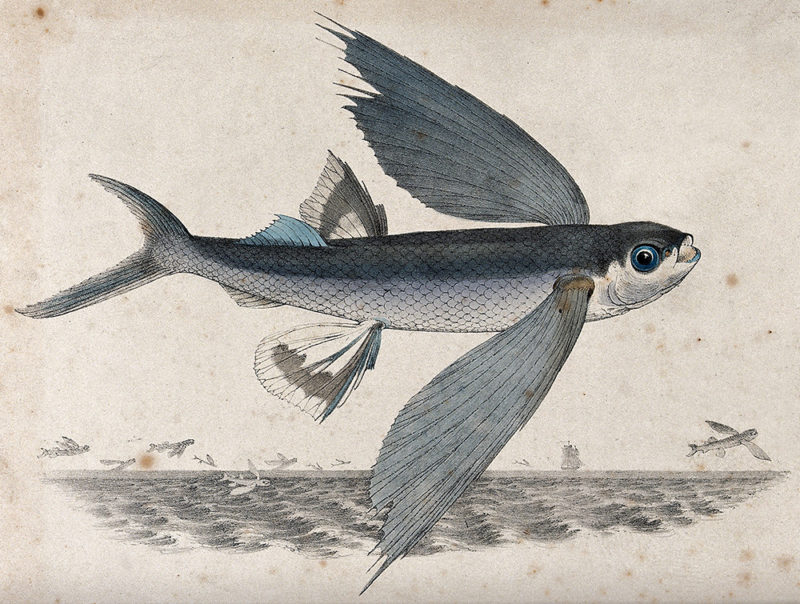
What Does Tobiko Taste Like?
Tobiko has a crunchy texture with a satisfying pop. They have a mildly sweet and briny flavor. Tobiko also tends to have a citrusy taste similar to orange zest.
Additionally, most commercial examples of tobiko are cured with sake vinegar and mirin. The sweet-sour rice flavors of these ingredients don’t overpower the roe, however.
Dashi or dashi extract is also commonly used for curing commercially available tobiko. This adds umami and a subtle smoky flavor.
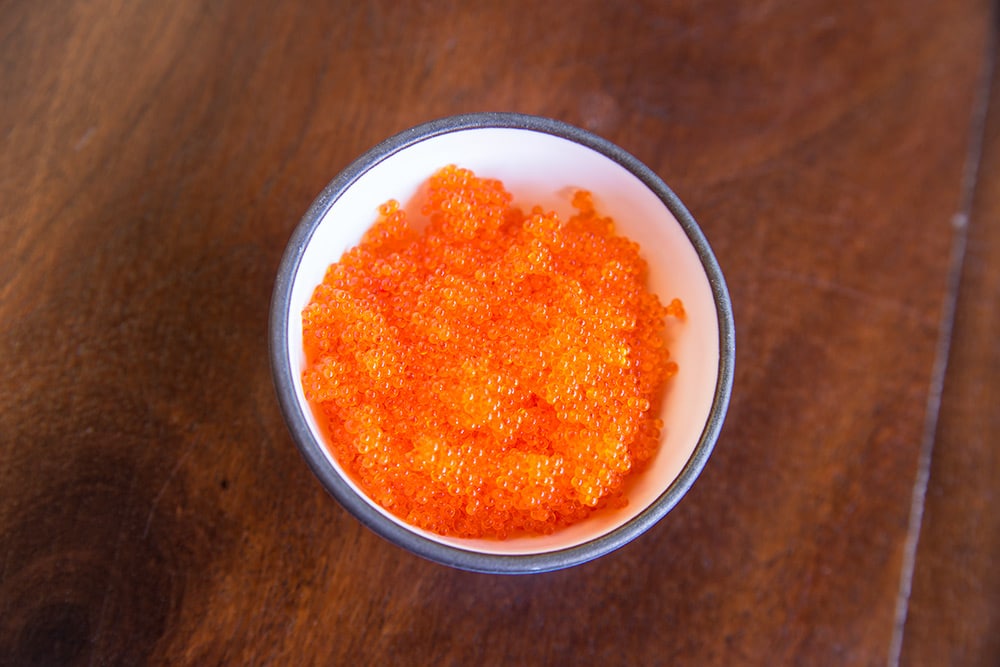
Types of Tobiko
High-end, fresh tobiko will usually be cured simply in salt. This will have a light golden color and a sweet-briny flavor.
But the vast majority of tobiko one will encounter are processed with many more ingredients than simply salt.
A variety of commercial flying fish roe types of been popularized. They can be differentiated by color and usually have an added ingredient or two that makes them taste and look somewhat different.
As mentioned previously, most commercial examples of tobiko will contain sake vinegar and mirin. Soy sauce, salt, and sugar are also commonly used for curing. Preservatives and food coloring are also standard ingredients. And lastly, some commercial examples of flying fish roe will contain dashi or dashi extract.
Below we detail the most common varieties of tobiko.
Golden Tobiko
High-quality and fresh tobiko may be called golden tobiko. This would be cured simply in salt and have a milder flavor profile than most commercial examples.
Most of the time, golden tobiko will be processed with the standard curing ingredients and preservatives. Food coloring may also be used.
Orange Tobiko
Orange tobiko is the most common type of commercially processed flying fish roe. It has a sweet, briny, and citrusy flavor. Orange zest, steamed rice, and mild smoke notes are also present.
Orange tobiko rose to fame in the West because it’s often placed on top of California rolls. Today, orange tobiko and masago are commonly interchanged on this classic sushi roll. Tobiko has a much crunchier texture than masago, however.
Salt, sugar, soy sauce, rice vinegar, mirin, dashi extract, and preservatives are all often used for curing. FD&C Yellow No. 6 (sunset yellow) is used for coloring.
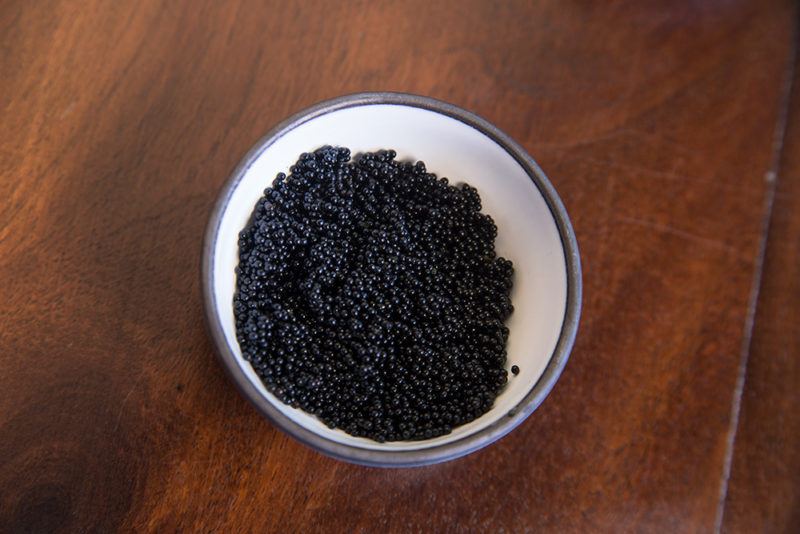
Black Tobiko
Black tobiko gets some of its inky appearance from squid ink. This type of flying fish roe has a similar flavor to other commercial varieties, but a bit more umami and a flavor similar to octopus. Black tobiko also has a mild nutty and bitter taste.
Black tobiko has an opaque appearance. This is unlike other forms of flying fish eggs with are translucent.
A variety of ingredients are used to cure and color black tobiko. Besides squid ink, FD&C Yellow #6, Blue #1, and Red #40 food colorings are also common. The usual slate of salt, sugar, mirin, sake vinegar, dashi extract, and preservatives are also used in the curing process.
Yellow Tobiko
Yellow tobiko is usually flavored with yuzu and/or other types of citrus. It has a bright yellow color that’s usually derived from food dye.
Some commercial varieties of yellow tobiko use ginger, as well.
Like other commercial types of flying fish eggs, yellow tobiko is usually cured with some combination of salt, sugar (or fructose), mirin, rice wine vinegar, and soy sauce. Dashi or dashi extract is also common.
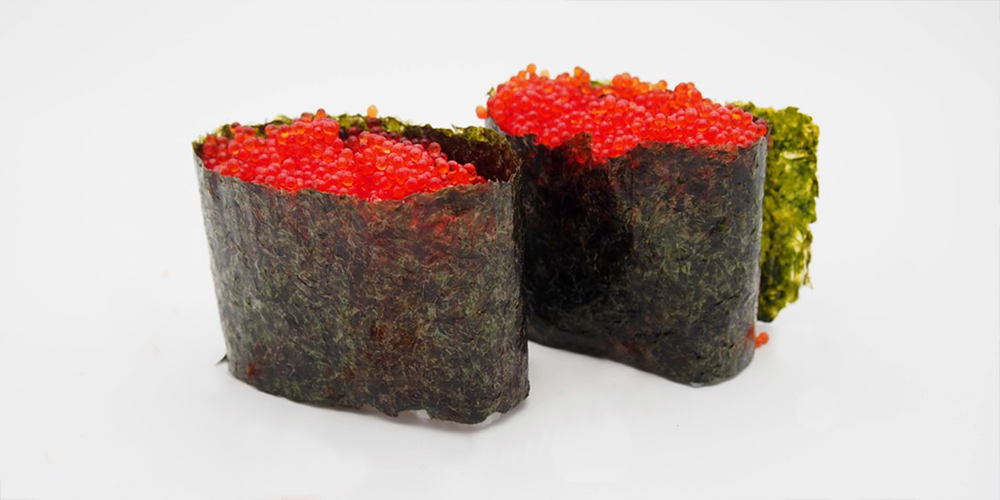
Red Tobiko
Red tobiko gets its color and added flavor from beets or chilis. The flavor of red tobiko will have a bit of spice if chili is used. Otherwise, it is very similar to orange tobiko.
Besides beets or chilis, FD&C Yellow #6, Blue #1, and Red #40 food dyes are also used to produce red tobiko’s vibrant color. A combination of salt, sugar, mirin, sake vinegar, dashi extract, and preservatives are also commonly used for curing and flavoring.
Wasabi Tobiko
Wasabi tobiko has a spicy flavor derived from wasabi or wasabi extract. It’s otherwise similar in flavor and texture to other types of flying fish roe.
Green tobiko is another name for this type of flying fish roe. Food dyes FD&C Yellow #5 and Blue #1 are usually used to added to create a vibrant green color.
Common curing and flavoring ingredients for wasabi tobiko include salt, sugar, mirin, sake vinegar, soy sauce, and dashi extract. Preservatives are almost always used, as well.
Tobiko vs Masago
Masago is a type of smelt roe and is often mistaken for tobiko. It’s slightly smaller than flying fish eggs and comes in the same assortment of flavors and colors. The main difference is that masago has a slightly softer texture.
Click the link to learn more about the similarities and differences between tobiko and masago.
Other Fish Roe for Sushi
Ikura is salmon roe and another popular sushi bar item. It is much larger than tobiko with a softer, gooier texture. The flavor of salmon roe is also saltier with more umami than flying fish roe.
Where to Buy Tobiko
Both of these ingredients are easy to find in Japanese restaurants. But if you want to use them to make your own sushi at home, you’ll have to look a little harder.
Some Japanese markets sell frozen masago and/or tobiko. Uwajimaya and Mitsuwa are two chains worth checking out. High-end seafood markets are also worth a shot.
But for most of the country, shopping online is the easiest, cheapest, and fastest way to buy tobiko and masago.
Below are a few online retailers with quality roe. I’m an affiliate advertiser for some of them and may earn commissions on qualifying purchases.
Buy Tobiko Online
Tobiko Sushi
The most common way tobiko is used in sushi restaurants is on the outside of uramaki. The California roll is the most famous of these inside-out rolls and helped popularize tobiko in the West.
You’ll also often find tobiko placed on top of nigiri as a colorful garnish. And it’s also commonly used on chirashi sushi.
Gunkan tobiko isn’t commonly served at high-end sushi restaurants in Japan. However, tobiko sushi is popular at more modest sushi restaurants and izakayas.
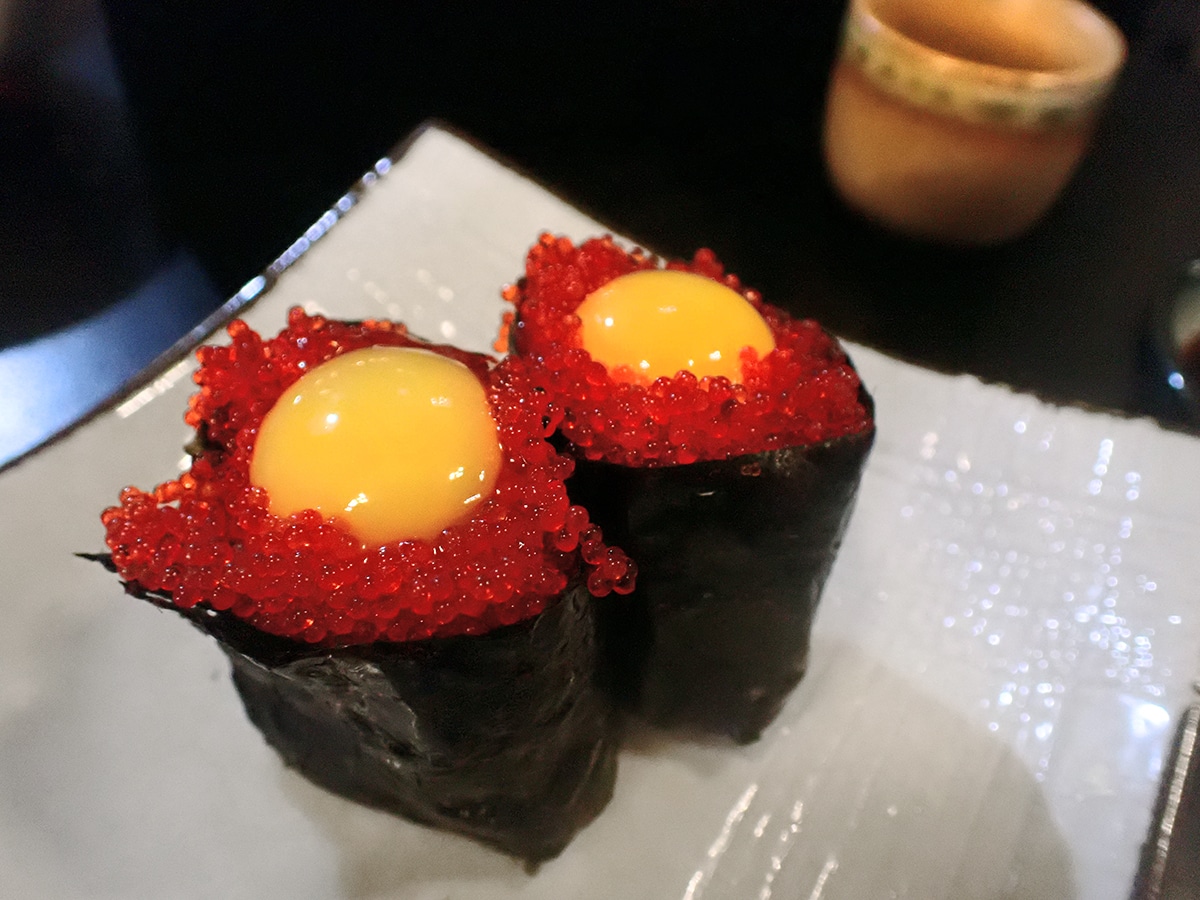
Pairing Drinks with Tobiko
Tobiko is pretty easy to pair with drinks. This is true of tobiko sushi or when it’s by itself.
One general tip for pairing tobiko sushi is to stick to milder drinks. Think pilsner, pinot grigio, and ginjo sake. Avoid beverages that are excessively rich or heavy.
Below I break down pairings by beverage category.
Pairing Tobiko with Sake
Sake is versatile with food in general, and most brands work great with flying fish roe.
Types of sake to look out for include yamahai, kimoto, extra dry sake (karakuchi), and sparkling.
Fruitier ginjo sake (junmai ginjo, ginjo, daiginjo, junmai daiginjo) is also excellent with tobiko sushi.
Beer Pairings
All the mainstream Japanese lagers pair well with flying fish roe: Sapporo Premium, Asahi Super Dry, Kirin Ichiban, etc. So will craft lagers and milder ales like Echigo Koshihikari and Yona Yona Pale Ale.
Outside of Japan, mainstream American lager is an effective palate cleanser. German Pils and Czech Pilsner are too, but they also add some malty umami to the combination.
Finally, the subtly smoked Schlenkerla Helles rauchbier is the bomb with tobiko sushi.
Wine Pairings with Tobiko
My general attitude towards pairing wine with tobiko sushi can be summed up as “white or rose and you’re ok.”
But if you must red wine, then I recommend lighter less tannic varietals and regions like Beaujolais, frappato, and zweigelt.
Dry white, sparkling, and most roses are going to pair nicely with tobiko sushi. Add a quail egg and slightly buttery chardonnay is worth a look.
Wasabi tobiko is
Learn more sushi and wine pairings to improve your next meal.
Shochu Pairings
Caviar and vodka are a classic combo. And this translates really well to clean, smooth honkaku shochu. In particular rice or barley shochu. Stick to brands between 20-24% ABV, or stronger genshu shochu with water (mizuwari).
Dietary and Nutritional Information
Flying fish eggs are nutrient-rich and low in calories and carbohydrates. It’s also loaded with Omega-3 fatty acids. Tobiko also has lots of protein and minerals.
Flying fish roe is rich in Vitamin B12, and has elevated levels of Vitamin C and E.
Tobiko also has very little mercury.
Its big downside is high levels of sodium. Curing also involves salt and sometimes soy sauce, which adds additional sodium.
Is Tobiko Gluten Free?
Naturally, tobiko contains no gluten. However, soy sauce is frequently used for curing. And soy sauce isn’t gluten-free.
So be sure to check the label or ask the sushi chef about the ingredients in their tobiko.
Proper Storage of Tobiko and Masago
Tobiko freezes well and doesn’t lose its flavor or texture once frozen. After it’s thawed, keep it refrigerated. It will taste best within 3 or 4 days.
Flying Fish Sustainability
Many species of flying fish are located around the world. The fish itself is popularly consumed (tobiou in Japanese) – a type of silver-skinned fish. And of course, flying fish eggs are extremely popular at sushi restaurants.
Adults and roe-based fisheries are often segregated.
Unfortunately, harvesting fly fish eggs limit the size of subsequent generations. Fish populations around southern Japan, Taiwan, and the East China Sea are considered healthy for now. But there is risk of overfishing.

Brad Smith
I fell in love with Japanese cuisine nearly two decades ago and soon landed my first Japanese restaurant job. Many years later, I created this site to geek out on Japanese food and beverage.
I love learning and my professional certifications include the J.S.A. Sake Diploma, Certified Sommelier (CMS), Certified Sake Advisor (SSA), Certified Shochu Advisor (SSA), Certified Specialist of Spirits (SWE), and Certified Beer Server (CCP).
Check out my about page to learn more.
